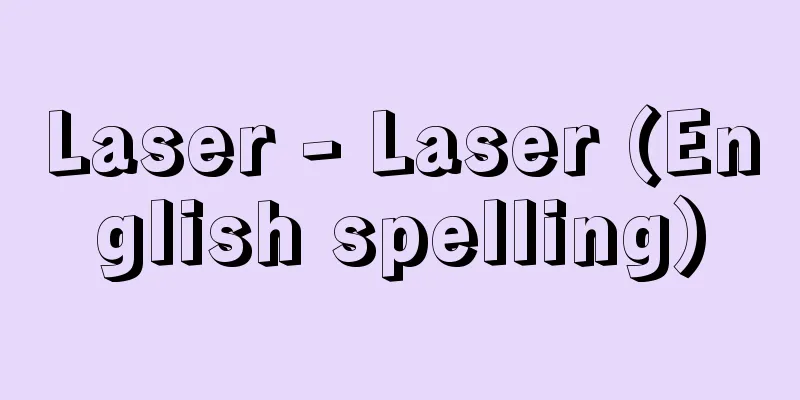Laser - Laser (English spelling)

|
A device that generates light (electromagnetic waves) by utilizing the properties of stimulated emission from excited atoms and substances. The term is an acronym for "light amplification by stimulated emission of radiation." The light itself that is generated is called laser light. Lasers are those with wavelengths ranging from submillimeter waves to the vacuum ultraviolet region, and those with wavelengths longer than millimeter waves are called masers. American physicists C. H. Towns and A. L. Schaulow specifically proposed the possibility of lasers as an extension of the maser invented in 1954, and Theodore Harold Maiman (1927-2007) first succeeded in emitting laser light using a ruby crystal in 1960. Since then, lasers have been invented one after another, and today a wide variety of lasers have been realized using a huge number of atoms, molecules, and substances. As a result, these lasers are used in a very wide range of fields in society, including things that are familiar to us. [Inoue Kuon] principleBasically, it is the same as the principle of a maser. A population inversion (a state in which the number of atoms or electrons in the higher energy level is greater than that in the lower energy level, also called a negative temperature state) is created between two appropriate energy levels of an atomic group (or substance). Induced by light with a frequency that resonates with the energy between the two levels, the atoms (electrons) in the higher energy level transition to the lower energy level, causing induced emission, which gives energy to the light. As a result, the intensity of the light incident from outside increases while maintaining the same frequency and phase. This is called coherent light amplification (the opposite phenomenon of light absorption that occurs in the normal case where there is no population inversion). If a negative temperature medium is placed inside an optical resonator and a part or a significant part of the amplified light is repeatedly sent back and forth (called feedback), self-sustained oscillation of the light occurs, resulting in a laser. shows the basic configuration. Even without external light being input, the weak light generated by spontaneous emission inside the resonator becomes a seed and oscillates only in one or more specific resonant modes of the optical resonator. Therefore, laser light is a wave with a uniform phase, and its properties are fundamentally different from ordinary light (ordinary light is spontaneous emission, so even a single spectral line from a sodium lamp is a myriad of light with slightly different frequencies and random phases). An optical resonator is basically two highly reflective plane mirrors (concave mirrors are also used) placed parallel to each other and separated by a distance much longer than the wavelength of light, and is called a Fabry-Perot resonator. In this case, standing waves perpendicular to the surface become the resonant modes, and the energy intervals of adjacent modes are the same. As will be described later, there are also distributed feedback resonators that do not use mirrors and use a one-dimensional periodic structure of refractive index (diffraction grating) in the direction of light propagation. Since there are a considerable number of resonant modes of light in the frequency range that can be amplified by the laser medium, it is common for lasers to oscillate in multiple modes simultaneously. A laser that oscillates in one mode by a special method is called a single-frequency laser. In addition to continuous wave lasers that emit light continuously, there are also lasers that emit light for a certain period of time, which are called pulse lasers. [Inoue Kuon] How to create a population inversionThere are various methods, but the most representative is the optical pumping method, which is mainly used in solid-state and liquid lasers. For example, four levels are used as shown in Atoms or molecules are excited from the ground level 0 to level 3 (usually a band) by light absorption when light is irradiated from a powerful lamp, another laser, or a light-emitting diode (a so-called LED, which has become widely used in recent years. It is also called a light-emitting diode). Electrons in these atoms, molecules, or solids move to level 2 by non-radiative transition in a short time, resulting in population inversion between levels 2 and 1. This is called a four-level laser. There are also three-level lasers that use the ground state 0 instead of 1 as the lower level and obtain a population inversion between levels 2 and 0. In gas lasers, when a rarefied gas is discharged to create a non-thermal equilibrium state, atoms are excited by collisions with ionized electrons, and a population inversion is realized between two appropriate excited energy levels (including the excited levels of ionized atoms as well as neutral atoms). Current injection type lasers are common in semiconductor lasers. When a pn junction is created and a forward voltage is applied, the recombination of the injected electrons and holes at the junction region causes light amplification. In other words, a population inversion occurs between the conduction band and the valence band. There are various other methods, such as electron beam irradiation and chemical reactions. Finally, in the free electron laser, a coherent light is generated by modulating an electron beam accelerated to high speed by an accelerator through a spatially modulated static magnetic field. It has the characteristics of being able to obtain a large output and to change the wavelength over a wide range. This laser does not use the discrete energy levels of atoms (neutral, ionic), molecules, atoms or electrons in solids, or the population inversion between bands, as in conventional lasers, but it is generally called a laser. As an example of another laser that does not require a population inversion, there is a method of obtaining coherent light by using the stimulated Raman effect or the optical parametric phenomenon, which are nonlinear optical phenomena, and are called the stimulated Raman laser and the parametric oscillator, respectively. [Inoue Kuon] Laser light characteristics(1) Excellent coherence. The interference distance of normal light is at most a few tens of centimeters even with a high-spectrum light source, whereas laser light can interfere even when separated by a much greater distance. (2) Good directivity (except for semiconductor lasers). Light travels in a straight line with only a small divergence determined by the diffraction limit. (3) It has excellent monochromaticity, i.e., extremely good spectral purity. A huge number of photons are concentrated in an extremely narrow spectral width. (4) Therefore, its brightness temperature is extremely high, several orders of magnitude higher than the brightness temperature of the solar surface, which is 6,000 K. (5) When light is focused by a lens, the optical energy passing through a unit area per unit time (Poynting vector) is very large. In particular, in the case of pulsed laser light, the flash optical output is large and reaches an enormous value. As a result, the electric field strength (and magnetic field strength) of the light is extremely large, easily reaching values of about 10 8 V/m or more. (6) In special cases, extremely short light pulses of about 10-13 seconds can be obtained. Recent research has also produced ultrashort light pulses lasting only a few femtoseconds (1 femtosecond = 1 quadrillionth of a second), for example, about 2 x 10-15 seconds (this corresponds to light oscillating for only one cycle or less). [Inoue Kuon] Laser TypeIn terms of wavelength range, there are ultraviolet lasers, visible lasers, infrared lasers, far-infrared lasers, vacuum ultraviolet lasers, and X-ray lasers. In terms of operating medium, there are gas, solid, liquid, and semiconductor lasers. [Inoue Kuon] Gas LaserGas lasers use neutral atoms, ionized atoms, or molecules as the working substance. Examples include the helium-neon laser (wavelength 633 nanometers), the argon ion laser (wavelengths 488 and 515 nanometers), the carbon dioxide laser (wavelengths 9.4 and 10.4 micrometers), and excimer lasers such as xenon chloride and argon fluoride (wavelengths 308 and 193 nanometers, respectively). [Inoue Kuon] Solid-state laserSolid-state lasers are made of transition metal or rare earth element ions dissolved in homogeneous crystals or glasses, or in optical fibers with a small amount (0.1 to several percent) of impurities, or crystals containing color centers. Typical solid-state lasers include the ruby laser (wavelength 694 nanometers) in which chromium ions are mixed into sapphire crystal, the Nd-YAG laser (wavelength 1.06 micrometers) in which neodymium ions are placed in yttrium aluminum garnet crystal or glass, the glass laser (wavelength 1.05 micrometers), and the titanium sapphire laser. In particular, the titanium sapphire laser has a wide range of applications because the wavelength of the laser can be continuously changed by a wavelength selection element placed in the resonator (wavelength tunable range is 680 to 1100 nanometers). This laser is also suitable for generating ultrashort pulses as mentioned above by using the mode-locking method (a method of locking the optical phase between modes when oscillating in multiple resonant modes of a Fabry-Perot resonator). [Inoue Kuon] Liquid LaserAmong liquid lasers, dye lasers, which dissolve dye molecules such as rhodamine in an organic solvent and excite them using optical pumping, are important. Like the titanium sapphire laser mentioned above, they are used as tunable lasers (the wavelength tuning range varies depending on the type of dye) or to generate ultrashort pulses. [Inoue Kuon] Semiconductor laserIn terms of the impact on society, or in the industrial world, semiconductor lasers (also called laser diodes) are the most important. Semiconductor lasers use III-V and IV-VI compound semiconductor crystals, such as direct transition gallium arsenide GaAs (wavelength 830-900 nm), or ternary or quaternary mixed crystals of these. The latter are AlGaAs or GaAsP (both wavelengths 630-900 nm), InGaN (wavelength 400-470 nm), InGaAsP (wavelength 1-2 μm, mainly used for optical fiber communication), and the oscillation wavelength can be selected by the composition ratio. Semiconductor lasers are used with current drive (excitation), and generally use the cleavage planes (smooth surfaces created by splitting the crystal along a specific direction) at both ends of the semiconductor laser material itself as a resonator, without using any external mirrors (relatively high reflectivity). In the early days of semiconductor lasers, a simple pn junction structure was used, in which there were no p-type or n-type AlGaAs layers above or below the active layer, as shown in , in order to effectively confine both electrons and light in the active region, a double heterostructure of semiconductor quantum wells (a structure in which two different types of semiconductor materials are artificially stacked in thin layers, with electrons confined in one layer) as shown in Figure C and backward feedback by a distributed feedback resonator have become common (in practice, a buried heterostructure that confines light to a narrow region not only in the thickness direction of the active region but also in the lateral direction is often used). This type of laser has excellent characteristics, such as a small driving current. Also, instead of the Fabry-Perot type resonator using the cleavage plane, a single-mode type that uses a distributed feedback resonator to feed back only a specific wavelength has been developed and is mainly used for optical communication. In general, a notable feature of semiconductor lasers that other lasers do not have is their very small size (typically 100 to 500 micrometers in length). Also important are vertical cavity surface emitting lasers (VCSELs), which generate laser light perpendicular to the direction of electron propagation (perpendicular to the laser substrate surface). Semiconductor lasers can be driven by small current sources, and are very small and inexpensive, making them easy to incorporate into devices and allowing for a wide range of uses. For example, they are used as light sources for optical communications, compact discs, and barcode readers. Semiconductor lasers are also superior in terms of the intensity of their output light, frequency stability, and the ease of single-mode oscillation. In general, solid-state lasers are suitable for generating high power output, while gas lasers have excellent coherence. The latter also have a wide range of wavelengths that can be used, and some have high power output. In general, a large pulsed flash light output can be obtained by pulsing the excitation. It is also possible to obtain high power output (50 megawatts, 30 nanoseconds is easy) by storing a large number of atoms in the upper level and concentrating stimulated radiation in a short period of time using the Q-switching method. [Inoue Kuon] Use of lasersLasers are used in a very wide range of applications due to their excellent properties. (1) It has had a great impact on the development of basic science. First, it created a new academic field called nonlinear optics. As a result, in addition to the usual phenomena such as absorption and emission that are proportional to the intensity of the incident light, various nonlinear phenomena that are not proportional to the intensity of the incident light were discovered. For example, when the intensity of the incident light is proportional to the square or cube of the intensity of the incident light, light with frequencies twice or three times that of the incident light is generated, respectively. Nonlinear optics has made it possible to explore new properties and functions of materials and develop various new spectroscopy methods. Next, when a laser is used as a light source, ultra-high resolution spectroscopy and ultra-high sensitivity spectroscopy become possible, and the detailed structure of atoms and materials can be elucidated. Since it is possible to selectively excite special electronic states in atoms, molecules, and solids, it is possible to investigate the structure and properties of those states, the energy relaxation mechanism, and the microscopic mechanism of chemical reactions. Laser spectroscopy can also virtually stop the movement of atoms (called laser cooling). These stationary atoms have made it possible to study various new phenomena (such as Bose-Einstein condensation of atomic gases). Furthermore, the use of ultrashort light pulses can provide insight into ultrafast time changes in physical, chemical, and biological phenomena, helping to elucidate phenomena at the microscopic level. Finally, a new academic field that combines the laser itself with the above fields is called quantum optics. Recent advances in this field include the verification of various phenomena related to the foundations of quantum mechanics and research into their applications, such as the generation and detection of phase-squeezed states, quantum cryptography, quantum teleportation, and quantum computers. One application of ultra-high resolution spectroscopy is the separation of isotopes such as uranium using lasers. Laser light scattering spectroscopy such as Raman scattering is also widely used. It is powerful in analyzing materials, that is, in elucidating the elementary excitations that are responsible for the unique properties exhibited by each solid. Lasers are also used to create length standards, to precisely measure the acceleration of gravity, and to verify the theory of relativity. (2) Lasers also have a wide variety of practical applications. The excellent monochromaticity and directionality of laser light can be used to perform a variety of precise measurements. Lasers are used to measure distance, position, displacement, speed, and other things with high precision. For distance measurement, there is laser radar, which emits a narrow pulse of light and measures the time it takes for it to be reflected and return. There are many examples, such as the exact distance between the Earth and the Moon, the precise determination of the Earth's shape using artificial satellites, the precise measurement of distances between continents, and the measurement of cloud heights for meteorological purposes. Using the interference of light, lasers are used to measure minute displacements and fluctuations in mechanical systems with the precision of light wavelengths, to precisely measure particle diameters smaller than a micrometer, to measure crustal movements, and for predicting earthquakes, for example. They are also used as targeting devices, for example when digging straight tunnels, creating precise trajectories for charged particle accelerators, and precisely aligning the many panel boards on the 45-meter-diameter radio telescope in Nobeyama, Nagano Prefecture. Laser Doppler meters, which use the Doppler effect to accurately measure the speed of flying particles and objects, have also been put to practical use. Lasers can also be used to measure blood flow in the human body. Laser measurements are generally non-contact, making them suitable for use on vibrating parts, high voltage parts, high temperature parts, and the human body. In the field of environmental conservation, a laser can be emitted into the atmosphere to analyze the scattered light from various suspended molecules, allowing the type, concentration distribution, and location of these molecules to be determined. Lasers can also be used to measure temperature, allowing the identification of the combustion temperature of a flame or a car engine, as well as the type and distribution of molecules contained therein. When a high-power laser is focused, it becomes highly energy dense and can produce extremely high temperatures, making it useful for processing, cutting, welding, and other applications. It is used for drilling and cutting diamonds, metals, and fabrics, for ultra-fine processing of ultra-LSIs, and for writing on ICs. It has the advantage of not requiring a vacuum compared to electron beam processing. It is also used for surface treatment (annealing) such as hardening metals, and for melting and crystallizing materials evaporated onto a substrate using laser irradiation to create new materials. In medicine, it is used to stitch together detached retinas and in laser scalpels for surgical operations. It has the advantage of being non-contact and capable of coagulating blood. It also has many other medical applications, such as laser endoscopes and blood flow tests. Research is also being conducted on nuclear fusion using high-power lasers, taking advantage of the extremely high temperatures. One application of light as a wave is optical communication. Since light has a high frequency as an electromagnetic wave, the transmission frequency band is much wider than that of microwaves, making it possible to send large amounts of information. Optical fiber transmission is being put to practical use in domestic and intercontinental telephone communication networks (Internet, mobile phone networks, etc.). Semiconductor lasers are used as light sources, and optical amplifiers on the ocean floor between continents use optically excited europium ions (in the 1.55 micrometer band) dissolved in optical fiber. However, in long-distance optical communication using optical fiber, it is not yet possible to utilize laser coherency as in the radio wave domain. Taking advantage of this good coherence, a new information recording method called holography has emerged. While normal photography only records the intensity of light, this method also records information on the phase of the object wave, recording the interference fringes between the object wave and another laser beam. The film is played back by shining a laser on it, and the image changes depending on the viewing angle, recreating a three-dimensional image. Since many images can be recorded simultaneously on a single sheet of film, it is also suitable for recording large amounts of information and has a wide range of applications. Optical discs are also widely used for storing information. They use a laser to create rows of small holes for recording, and another small laser is used to read them. They are suitable for large-volume recording and are also used in computers. Their resistance to noise has led to the widespread use of audio compact discs, video discs, and DVDs. Other applications include high-speed laser printers, fax machines, and printing machines, as well as everyday items such as laser art and barcode readers found in supermarkets. The list is endless. [Inoue Kuon] "Introduction to Laser Physics" by Koichi Shimoda (1983, Iwanami Shoten)" ▽ "Introduction to Lasers - From Fundamentals to Applications" by J. Wilson and J.F.B. Hawkes, supervised translation by Tadao Shimizu (1992, Morikita Publishing)" ▽ "Optoelectronics Fundamentals" by A. Yariv, supervised translation by Kunio Tada and Takeshi Kamiya, 5th edition (2000, Maruzen)" ▽ "Quantum Optics" by Takahiro Kuga (2003, Asakura Shoten)" ▽ "The World of Lasers" by J. Hecht and D. Teresy, translated by Kiyoshi Isaka (Kodansha, Bluebacks)" [References] | | | | | | | |The reflectance of R is close to 100%, and the reflectance of R on the output side is less than 100% ©Shogakukan "> Basic configuration of an optically pumped solid-state laser (Fig. A… ©Shogakukan "> Four-level laser (schematic diagram of energy levels… ©Shogakukan "> GaAs-AlGaAs double heterostructure... Source: Shogakukan Encyclopedia Nipponica About Encyclopedia Nipponica Information | Legend |
|
励起状態にある原子、物質の誘導放射の性質を利用して光(電磁波)を発生させる装置をいう。light amplification by stimulated emission of radiation(誘導放射による光の増幅)の頭文字からつくったことばである。発生する光そのものをレーザー光という。サブミリ波から真空紫外光領域に至る波長範囲のものをレーザーといい、ミリ波より長波長のものは別にメーザーという。 1954年に発明されたメーザーの拡張としてアメリカの物理学者C・H・タウンズとA・L・ショウロウがレーザーの可能性を具体的に提唱し、1960年にルビー結晶でメイマンTheodore Harold Maiman(1927―2007)が初めてレーザー発振に成功した。以後、次々とレーザーが発明され、現在では非常に多くの原子、分子、物質を用いて多種多様なレーザーが実現している。その結果、われわれの身近なものも含めて社会の非常に広範な分野において、これらのレーザーが使われている。 [井上久遠] 原理基本的にはメーザーの原理と同じである。原子集団(または物質)の適当な二つのエネルギー準位間で反転分布(エネルギーの高い準位の原子分布数または電子分布数が低い準位より多い状態をいい、負温度状態ともいう)をつくる。二つの準位間のエネルギーに共鳴する周波数をもつ光に誘発されて上の準位の原子(電子)が下の準位に遷移してエネルギーを光に与える誘導放射がおこる。その結果、外部から入射させた光は周波数、位相が同じままで強度が増大する。これをコヒーレント(可干渉)な光の増幅という(反転分布がない通常の場合に生じる光吸収の逆の現象である)。負温度媒質を光の共振器の中に置き、増幅された光の一部分または相当部分を繰り返し往復させる(帰還―フィードバックさせるという)と、光の自励発振がおこりレーザーとなる。に基本構成図を示す。外部から光を入れなくとも共振器内部で自発放射で発生する弱い光が種となって光共振器の特定の一つ、または複数の共振モードでのみ発振する。したがってレーザー光は位相のそろった波となり、通常の光とは本質的に性質が異なる(通常の光は自発放射によるものであるので、たとえば、ナトリウムランプから取り出した一つのスペクトル線の光でも周波数が少しずつ異なった無数の、そして位相も無秩序な光である)。光の共振器は基本的には反射率の高い二つの平面鏡(凹面鏡も使う)を、光の波長よりはるかに長い距離だけ離して互いに平行に向かい合わせて置いたもので、これをファブリー・ペロー型共振器という。この場合には面に垂直な定在波が共振モードになり、隣り合ったモードのエネルギー間隔は同じになる。後述するように、鏡を用いずに、光を伝搬させる方向に一次元の屈折率の周期構造(回折格子)を利用する分布帰還型共振器もある。レーザー媒質で増幅可能な周波数範囲にかなりの数の光の共振モードが存在するので、複数個のモードでレーザーが同時に発振するのが普通である。特殊な方法により一つのモードで発振させたものを単一周波数レーザーという。なお、連続的に光が持続する連続波レーザーのほかに、一定時間だけ光が持続するレーザーもあり、これをパルスレーザーという。 [井上久遠] 反転分布をつくる方法方法はさまざまであるが、代表的なものに光ポンピング法があり、固体、液体レーザーでおもに用いる。たとえばに示したように四つの準位を利用する。強力なランプ、他のレーザー、あるいは光放射ダイオード(いわゆるLEDで、近年多用されるようになった。発光ダイオードともいう)からの光を照射して、光吸収により基底準位0から準位3(多くはバンド)に原子あるいは分子を励起する。これらの原子、分子、あるいは固体中の電子は短時間に非放射遷移により2の準位に移り、その結果2と1の準位間で反転分布が生じる。これを四準位レーザーという。下の準位として1のかわりに基底状態0を用い、準位2と0の間で反転分布を得る三準位レーザーもある。気体レーザーでは希薄にした気体を放電し非熱平衡状態にすると、電離した電子との衝突により原子が励起され適当な二つの励起エネルギー準位間(中性原子のほかに電離した原子の励起準位も含む)で反転分布が実現する。半導体レーザーでは電流注入型レーザーが一般的である。pn接合をつくり、順方向に電圧をかけると、接合領域で注入された電子と正孔の再結合により光の増幅がおこる。つまり伝導帯と価電子帯の間で反転分布が生じる。ほかにも電子ビーム照射や、化学反応を利用した方法などいろいろある。最後に、自由電子レーザーでは、加速器により高速に加速された電子ビームを、空間変調された静磁場中に通し変調することにより、コヒーレントな光を発生させている。大出力が得られること、および広い範囲で波長を変えられる特色がある。このレーザーでは、通常のレーザーのように原子(中性、イオン)、分子、固体中の原子または電子の離散的なエネルギー準位、あるいはバンド間の反転分布を利用していないが、一般的にレーザーとよんでいる。なお反転分布を必要としない他のレーザーの例として、それぞれ非線形光学現象の一つである誘導ラマン効果あるいは光パラメトリック現象を利用してコヒーレントな光を得る方法があり、それぞれを誘導ラマンレーザーおよびパラメトリック発振器とよんでいる。 [井上久遠] レーザー光の特性(1)可干渉性(コヒーレンス)に優れている。通常の光の干渉可能な距離が優れたスペクトル光源でもたかだか数十センチメートルなのに対し、レーザー光でははるかに遠く離しても干渉する。 (2)指向性がよい(ただし、半導体レーザーを除く)。回折限界できまるわずかな広がりで直進する。 (3)単色性に優れている、すなわちスペクトル純度がきわめてよい。極端に狭いスペクトル幅の中に膨大な数の光子が集中している。 (4)したがって、輝度温度が非常に高い。太陽表面の輝度温度6000Kより桁(けた)違いに高温である。 (5)レンズで集光すると、単位面積を単位時間に通過する光エネルギー(ポインティングベクトル)が非常に大きい。とくにパルスレーザー光の場合、閃頭(せんとう)光出力が大きく莫大(ばくだい)な値となる。その結果、光の電場の強さ(磁場の強さも)はきわめて大きく108V/m程度あるいはそれ以上の値に容易に達する。 (6)特別な場合、10-13秒程度の極端に短い時間幅の光パルスが得られる。なお、最近の研究では、わずか数フェムト秒(1フェムト秒=1000兆分の1秒)だけ持続する(たとえば2×10-15秒程度の時間幅の)超短時間光パルスも得られている(これは1サイクルあるいはそれ以下しか振動しない光に対応する)。 [井上久遠] レーザーの種類波長領域による種類では、紫外レーザー、可視レーザー、赤外レーザー、遠赤外レーザー、さらに真空紫外レーザー、X線レーザーがある。動作媒質に関しては気体、固体、液体、半導体の各レーザーの種類がある。 [井上久遠] 気体レーザー気体レーザーは動作物質として中性原子、電離原子、分子を用いたものである。ヘリウムネオンレーザー(波長633ナノメートル)、アルゴンイオンレーザー(波長488と515ナノメートル)、炭酸ガスレーザー(波長9.4と10.4マイクロメートル)、塩化ゼノン、フッ化アルゴン(波長はそれぞれ308と193ナノメートル)などのエキシマーレーザーなどが代表的なものである。 [井上久遠] 固体レーザー固体レーザーは遷移金属、希土類元素イオンを均一性のよい結晶あるいはガラス、もしくは光ファイバーに不純物としてわずかな量(0.1~数%)を溶かしたものや、色中心を含む結晶が用いられる。クロムイオンをサファイア結晶に混入させたルビーレーザー(波長694ナノメートル)、ネオジムイオンをイットリウム・アルミニウム・ガーネット結晶またはガラスに入れたNd‐YAGレーザー(波長1.06マイクロメートル)、ガラスレーザー(波長1.05マイクロメートル)、チタンサファイアレーザーなどが代表的なものである。とくに、チタンサファイアレーザーは共振器内に入れた波長選択素子によりレーザーの波長を連続的に変えることができるので広い用途がある(波長可変範囲は680~1100ナノメートル)。このレーザーはまた、モード同期法(ファブリー・ペロー共振器の多数の共振モードで発振する場合に、モード間の光の位相を固定する方法)を用いることにより、すでに述べた超短時間パルスを発生させるのにも適している。 [井上久遠] 液体レーザー液体レーザーではローダミンなどの色素分子を有機溶媒に溶かし、光ポンピング法で励起する色素レーザーが重要である。前述のチタンサファイアレーザーと同様に波長可変レーザーとして(色素の種類によって波長可変範囲が異なる)、あるいは超短時間パルス発生用として使われている。 [井上久遠] 半導体レーザー社会に与えた影響の大きさの観点からは、あるいは産業界では、半導体レーザー(レーザーダイオードLDともいう)がもっとも重要である。半導体レーザーは直接遷移型のヒ化ガリウムGaAs(波長830~900ナノメートル)などのⅢ―Ⅴ族、Ⅳ―Ⅵ族化合物半導体結晶や、これらの三元、四元混晶が使われている。後者はAlGaAsあるいはGaAsP(ともに波長630~900ナノメートル)、InGaN(波長400~470ナノメートル)、InGaAsP(波長1~2マイクロメートル。主として光ファイバー通信用に使われている)などで、組成比によって発振波長を選ぶことができる。半導体レーザーは電流駆動(励起)で用い、また共振器として、とくに外部の鏡を用いないで、レーザー材料の半導体自身の両端の劈開(へきかい)面(結晶をある特定の方向に沿って割ることによって生ずる平滑な面)を用いるのが一般的である(反射率が比較的高い)。初期のころの半導体レーザーでは、で活性層の上下のp型、n型のAlGaAs層がともにない単純なpn接合の構造を用いていた。最近では、電子も光も活性領域に効果的に閉じ込めるために、に示したように半導体量子井戸(異なる2種類の半導体材料を薄い層状に交互に人工的に積み重ねた構造で、一つの層の中に電子が閉じ込められる)の二重ヘテロ構造を用い、かつ分布帰還型共振器による後方フィードバックを用いたものが汎用されている(実際には活性領域の厚さ方向のみならず、横方向に関しても狭い領域に光を閉じ込める埋込みヘテロ構造を用いる場合が多い)。このタイプのものは、駆動電流が小さくてすむなど優れた特性をもっている。また、前記の劈開面を利用したファブリー・ペロー型共振器のかわりに、分布帰還型共振器を用いて特定の波長のみをフィードバックする単一モード型も開発され、おもに光通信用に活用されている。一般に、半導体レーザーはサイズが非常に小さい(典型的には長さが100~500マイクロメートル)点が他のレーザーにない顕著な特色である。ほかに、電子の伝搬方向と垂直(レーザー基板面と垂直)な方向にレーザー光が生じる垂直共振器面発光半導体レーザー(VCSEL:Vertical Cavity Surface Emitting Laser)も重要である。半導体レーザーは小型電流源で駆動でき、サイズが非常に小さく安価なので、機器に組込みが容易であり使用用途が多い。たとえば、光通信用の光源、コンパクトディスク、バーコードの読取りなどに使われている。なお、半導体レーザーは出力光の強度、周波数の安定度、単一モード発振が容易であるなどの点でも優れている。 一般に固体レーザーは大出力発生に適し、気体レーザーはコヒーレンスに優れている。後者はまた使える波長範囲が広く、ものによって大出力のものもある。一般に励起をパルスにすると大きなパルス閃頭光出力が得られる。また、上の準位に多量の原子をためておき短い時間に誘導放射を集中しておこさせるQスイッチ法により大出力(50メガワット、30ナノ秒程度は容易)を得ることもできる。 [井上久遠] レーザーの活用レーザーはその優れた特性のために非常に広範囲に利用されている。 (1)基礎科学分野の発展に大きな影響を与えた。まず非線形光学nonlinear opticsという新しい学問分野を生み出した。これにより、入射光強度に比例する吸収、発光などの通常の現象のほかに、入射光強度に比例しないさまざまな非線形現象が発見された。たとえば入射光強度の2乗、3乗に比例する場合には、それぞれ入射光の2倍、3倍の周波数の光が発生する現象がわかりやすい例である。非線形光学は物質のもつ新しい特性、機能の開拓や種々の新しい分光法の開発を可能にした。次にレーザーを光源に用いると超高分解能分光や超高感度分光が可能となり、原子、物質の詳しい構造が解明できる。原子、分子、固体で選択的に特別な電子状態を励起できるため、その状態の構造・特性やエネルギー緩和機構、化学反応のミクロな機構などが調べられる。レーザー分光により原子の運動を事実上止めることもできる(レーザー冷却という)。この静止原子によりさまざまな新しい現象(たとえば原子気体のボース‐アインシュタイン凝縮など)の研究が可能になった。さらに超短時間光パルスを用いると物理、化学、生物現象で超高速時間変化の知見が得られるので、微視的レベルでの現象の解明に役だっている。最後に、レーザー自身と前記の分野を総合した新しい学問分野を量子光学とよぶ。最近のこの分野の進歩として、量子力学の基礎にかかわる種々の現象検証とその応用の研究があげられる。すなわち、それぞれ位相スクイーズ(圧搾)状態の発生と検出などと、量子暗号法、量子テレポーテーション、量子計算機である。 超高分解能分光の応用としてレーザーによるウランなどの同位体分離ができる。ほかに、ラマン散乱のようなレーザー光散乱分光法が普及している。物質の分析に、すなわちそれぞれの固体が示す固有な特性を担う素励起を解明するのに威力を発揮している。レーザーはまた長さの標準にも使われるし、重力加速度の精密測定や相対論の検証にも使われている。 (2)レーザーの実用的応用も多種多様である。レーザー光の優れた単色性、指向性を利用し種々の精密測定ができる。距離、位置、変位、速度などを高精度に測るのに利用される。測距には時間幅の狭いパルス光を飛ばし反射して戻るまでの時間を測るレーザーレーダーがある。地球と月の正確な距離、人工衛星を利用した地球の形の精密な決定、大陸間の距離の精密測定、あるいは気象用として雲の高さの測定など多くの例がある。 光の干渉を利用して機械系の微小変位、変動を光の波長の精度で測ることや、マイクロメートル以下の粒子の径の精密測定、地殻の変動測定、たとえば地震の予知用などにも利用されている。照準としての応用もある。トンネルをまっすぐに掘る場合、荷電粒子用の加速器の軌道を精度よくつくる場合、また長野県野辺山(のべやま)の直径45メートルの電波望遠鏡で多くのパネル板を正確に並べる場合などに用いられている。ドップラー効果を利用して飛行粒子、物体の速度を正確に測るレーザードップラー計も実用化されている。 レーザーにより人体の血流も測ることができる。レーザーによる測定は一般に無接触なため、振動部分、高電圧部分、高温部分、人体などで使うのに適する。 環境保全関係では、レーザーを大気中に飛ばして種々の浮遊分子からの散乱光を解析して、それらの種類、濃度分布および位置を調べることができる。レーザーにより温度測定も可能であり、炎や車のエンジンの燃焼温度、含まれる分子の種類、分布も同定できる。 高出力レーザーを集光すると高エネルギー密度になり超高温が得られるので、加工、切断、溶接などに使われる。ダイヤモンド、金属あるいは服地などの穴あけ、切断や超LSIなどの超微細加工、IC上の文字書きなどに使っている。電子ビーム加工法に比べて真空を必要としない利点がある。表面処理(アニーリング)として金属の焼入れや、基板上に蒸着した物質をレーザー照射で融解したうえで、結晶化させ新物質をつくるのにも使われている。医用では剥離(はくり)網膜のつなぎ合わせや、外科手術用のレーザーメスに利用されている。無接触でしかも血液を凝固させる利点がある。医用ではほかにもレーザー内視鏡や血流検査など多くの応用がある。なお、超高温を利用して大出力レーザーによる核融合の研究も進められている。 波動としての応用に光(ひかり)通信がある。光は電磁波として周波数が高いので伝送周波数帯域がマイクロ波に比べてはるかに広くとれ、大量の情報を送ることができる。光ファイバー伝送により国内、大陸間の電話通信網(インターネット、携帯電話網ほか)などの実用化が進んでいる。光源としては半導体レーザーを、大陸間の海底における光増幅器としては光ファイバー中に溶かし込んだユーロピウムイオン(1.55マイクロメートル帯の場合)などを光励起したものを用いている。なお、光ファイバーによる長距離光通信においては、現在のところ、いまだ電波領域におけるようにレーザーのコヒーレンシーを利用するには至っていない。 コヒーレンスがよいことを利用し、新しい情報記録法、ホログラフィーが登場した。通常の写真が光の強度のみを記録するのに対し、物体波の位相の情報も記録する方法で、物体波ともう一つのレーザー光との干渉縞(じま)を記録する。フィルムにレーザーを照射して再生するが、見る角度により像が変わり、三次元的像が再現する。1枚のフィルムに多くの像を同時に記録できるので大量情報記録にも適し広範な応用がある。 情報記録としてはほかに光ディスクが普及している。レーザーで小さな穴の列をつくって記録し、別の小型レーザーで読み取るもので、大容量記録に適し、コンピュータにも使われている。雑音に強いためオーディオコンパクトディスク、ビデオディスク、DVDなどが普及してきた。ほかにも応用として高速打ち出し可能なレーザープリンター、ファクシミリ、印刷機など、また身近なところでレーザーアート、スーパーマーケットなどにあるバーコードリーダーなど枚挙にいとまがない。 [井上久遠] 『霜田光一著『レーザー物理入門』(1983・岩波書店)』▽『J・ウィルソン、J・F・B・ホークス著、清水忠雄監訳『レーザ入門――基礎から応用まで』(1992・森北出版)』▽『A・ヤリーヴ著、多田邦雄・神谷武志監訳『光エレクトロニクス 基礎編』原著5版(2000・丸善)』▽『久我隆弘著『量子光学』(2003・朝倉書店)』▽『J・ヘクト、D・テレシー著、井坂清訳『レーザーの世界』(講談社・ブルーバックス)』 [参照項目] | | | | | | | |Rの反射率は100%に近い値、出力側のRの反射率は100%以下©Shogakukan"> 光励起固体レーザーの基本構成配置〔図A… ©Shogakukan"> 四準位レーザー(エネルギー準位の模式図… ©Shogakukan"> GaAs-AlGaAsの二重ヘテロ構造… 出典 小学館 日本大百科全書(ニッポニカ)日本大百科全書(ニッポニカ)について 情報 | 凡例 |
<<: Laser chemistry - Laser chemistry
Recommend
Katsunori - Katsunori
...Suzhou and Hangzhou were managed by Sun Long, ...
Picholine
Methylpyridine. C 6 H 7 N (93.13). Found in tar b...
Illegal publication
Publications that are made in violation of the law...
Wanizuka Mountains - Wanizukasanchi
The southern part of Miyazaki Prefecture, Nichina...
Disc recording
...For example, in the case of magnetic recording...
Amsterdam-Pleyel (English)
…In the midst of this crisis, on February 12, the...
Notornis (English spelling) takahe
A bird of the Rallidae family in the order Grui i...
Heteronymous hemianopsia (English spelling)
... Hemianopsia is when the right or left half of...
Float cart - Kashagata
In Kabuki, a female actor plays the role of an old...
Olt (river)
A tributary of the Danube. It flows through Romani...
Uruk - Uruk (English spelling)
An ancient Sumerian city in southern Mesopotamia....
Forssmann, W.
…Because a vein or artery is cut open and a cathe...
Avena test
A method for the microquantification of auxin usin...
Emergency medical information system
One of the information aggregation systems for em...
Thompson, SG (English spelling) ThompsonSG
…There are about 10 known isotopes, of which the ...
![Kodera [town] - Kodera](/upload/images/67cb8a50ec2d2.webp)








